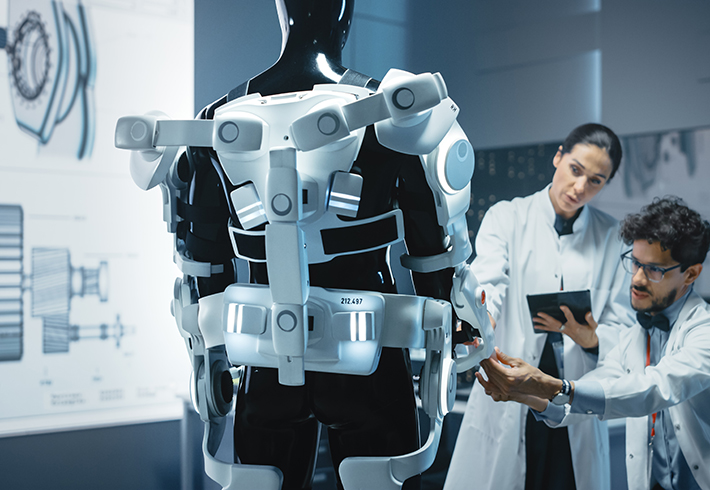
Exoskeleton Standards Come to the Medical Field
“The Wrong Trousers” is a 1993 British animated film starring the stop-motion characters of Wallace and Gromit. In it, Wallace comes into the possession of a pair of so-called “techno trousers,” or powered pants that he can use to walk up walls and across the ceiling. It’s a neat trick, until the trousers get hacked by a wanted criminal and Wallace ends up being forced to participate in a diamond heist against his will.
It’s a funny story, but it gets to the heart of the concerns that many people have about powered exoskeletons, or wearable machines: What happens if someone is able to take control of the machine while someone is wearing it?
That’s one of the reasons that ASTM International’s committee on exoskeletons and exosuits (F48) was formed in 2017 – to develop standards that address safety, quality, performance, ergonomics, and terminology for the systems and components that are used in these machines. Available in both powered and unpowered versions, exoskeletons are wearable mobile machines that use a system of motors, pneumatics, levers, hydraulics, and other technologies to support the wearer and give them increased strength and endurance. They have become popular for industrial applications, emergency response, construction, military use, and more, allowing wearers to easily lift and transport loads of hundreds of pounds and complete tasks that would be all but impossible without mechanical support.
Now medical applications can be added to that list.
READ MORE: The Future of Exoskeleton Standards
Powered exoskeletons are now also being used to help paraplegics walk again, to support stroke rehabilitation programs, and to ease the work that nurses do transporting patients. But the concerns that have long surrounded exoskeletons – security, safety, information sharing, structural integrity, and more – take on a new level of importance when the machines are being used in medical settings. That’s why F48 is prioritizing standards pertaining to medical exoskeletons as part of its list of work items this year and is also planning to survey medical exoskeleton users to find out more about the types of machines they are using and what specifically they are using them for.
“In my opinion, an exoskeleton must be controlled by the user ultimately,” says Bill Billotte, director of global exo technology programs at ASTM and a member of F48. “That's really, to me, the line between an exoskeleton and a robot, which can be fully autonomous. An exoskeleton is going to be, at most, semi-autonomous, where the person is going to be the final decider on any important decision. Everything we do has some connection to doing the best for the user and augmenting their own body.”
The committee’s seven approved standards each address some of these safety and functionality areas, but Billotte flagged two subcommittees that are focusing on standards for particular medical applications.
Subcommittee on Task Performance and Environmental Considerations (F48.03)
One of the newer standards developed by this subcommittee is the standard practice for load handling when using an exoskeleton (F3443). This applies not only to boxes or construction equipment, of course, but also load handling for moving patients and doing other healthcare work. The fact that this application involves medical personnel as well makes this sa relatively new area for medical exoskeletons.
Subcommittee on Security and Information Technology (F48.05)
Given the regulatory structure that exists around medical devices, there is a great need for exoskeleton standards that protect the user’s privacy and maintain HIPAA compliance, as well as from the worst-case scenario of someone hacking the machine while being worn. This new subcommittee is addressing the implications of the scenario mentioned above, addressing the security concerns arising from the incorporation of technologies like artificial intelligence, machine learning, and the algorithms that are learning from the user and adapting as they move around.
According to subcommittee chair Kalavati Bhashyam, “Our current focus is on the development of standards for secure transfer of information from exoskeletons to other systems, recovery of information from exoskeletons following catastrophic failure, and test methods to demonstrate the security of the technology.”
So far, most of the standards coming out of F48 apply to many different types of exoskeletons, not just medical. But the renewed emphasis on medical exoskeletons has been shaped by ASTM’s Exo Technology Center of Excellence (ET CoE). The ET CoE has focused on research proposals related to return-to-work, a critical need in the post-COVID world. For instance, using exoskeletons to help injured workers get back on the job bridges potential applications in industry as well as healthcare, as would using exotechnology to help workers take on new tasks they wouldn’t have been able to physically perform previously.
Billotte says the field of exoskeleton standards is focused on the medical area for a reason. “Right now there are no clear standards or guidance out there for this sort of use,” he says. “That's why we're putting so much emphasis on the medical area right now. There's just a huge need and a huge potential.” ■
 SN Home
SN Home Archive
Archive Advertisers
Advertisers Masthead
Masthead RateCard
RateCard Subscribe
Subscribe Email Editor
Email Editor